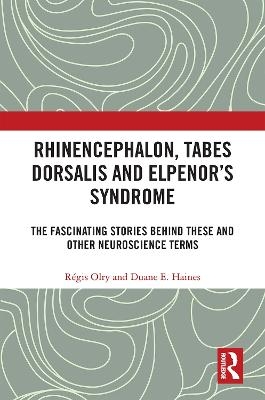
Rhinencephalon, Tabes dorsalis and Elpenor's Syndrome
Routledge (Verlag)
978-0-367-64651-6 (ISBN)
This book is a fascinating collection of various neuroscience terms coined over the last centuries. Each of the 45 chapters in this book dives deep into the etymologies, vernacular subtleties and historical anecdotes relating to these terms.
The book illustrates the rich and diverse history of neuroscience, which has borrowed and continues to borrow terms and concepts from across cultures, literature and languages. The ever-increasing number of terms that needed to be coined with the mushrooming of the field required neuroscientists to show astonishing imagination and creativity, leading them to draw inspiration from Graeco-Roman mythology (Elpenor’s syndrome), literature (Lasthenie de Ferjol’s syndrome), theatre (Ondine’s curse), Japanese folklore (Kanashibari), and even the Bible (Matthew effect). This book will of be immense interest to scholars and researchers studying neuroscience, history of science, anatomy, psychology and linguistics. It will also appeal to any reader interested in learning more about neuroscience and its history.
All the chapters included in this book were originally published in a column that appeared from 1997 to 2020 in the Journal of the History of the Neurosciences.
Régis Olry, MD, MSC (France), is Professor of Anatomy at the University of Québec, Trois-Rivières, Canada, and has previously held faculty positions in Germany (Heidelberg and Marburg). He has published numerous articles and three books on the history of anatomical terminology, and has received awards for university teaching and his articles on the origins of words and phrases in the neurosciences. Duane E. Haines, PhD, has held faculty positions at Wake Forest, Mississippi, West Virginia (Professor and Chairman), and at Medical College of Virginia. He is the author of numerous scientific papers and 15 books, including a brain atlas and a neuroscience text. He has held offices in scientific organizations and participated in the writing of Nomina Anatomica.
Rhinencephalon: A Brain for the Nose?
Fornix and Gyrus fornicates: Carnal Sins?
Cerebral Mythology: A Skull Stuffed With Gods
The Three Musketeers and the Twelve Cranial Nerves
Just What is the Inferior Cerebellar Peduncle?
Vague, Uncertain, Ambiguous, Obscure: Imprecision or Modesty?
Vater, Pacini, Wagner, Meissner, Golgi, Mazzoni, Ruffini, Merkel and Krause: Were their nerves all on edge?
The Subfornical and Subcommissural Organs: Never-Ending Rediscoveries
Arachnophobia: Spiders and Spider’s Webs in the Head
Claustrum: A Sea Wall Between the Island and the Shell?
Phantom Limb: Haunted Body?
Lasthénie de Ferjol’s Syndrome: A Tribute Paid by Jean Bernard to Jules Amédée Barbey d’Aurevilly
Ansa Hypoglossi or Ansa Cervicalis: That is the Question…
Reissner’s Fibre: The Exception Which Proves the Rule, or the Devil According to Charles Baudelaire?
If there are "Deep" Cerebellar Nuclei, Where are the "Superficial" Ones?
"James Parkinson did not die of his own personal disease… he died of a stroke" Eponyms: Possessive or Nonpossessive?
Give a Kiss to a Frog and it Will Turn into… A Neuropeptide: The Genealogy of the Bombesin-Like Family
Nomenclature of Persistent Carotid Vertebrobasilar Anastomoses
Interthalamic Adhesion: Scruples About Calling a Spade a Spade?
Herophilus’ Press, Torcular and Confluens Sinuum: A Triple Mistake
From Dante Alighieri’s First Circle to Paul Donald MacLean’s Limbic System
Elpenor’s Syndrome: The Link Between One of Ulysses’ Companions and the Tenth President of the Third French Republic
Munchausen Syndrome By Proxy: Karl Friedrich Hieronymus, Baron von Münchhausen, Hasn’t Got Anything To Do With It
Oedipus Complex: A Confession to a Berlin Otorhinolaryngologist that Became a Cornerstone of Psychoanalysis
The Brain in its Birthday Suit: No More Reason to be Ashamed
The Pen Nib and the Bolt: The Rhomboid Fossa of the Fourth Ventricle or the Symbol of the Censorship of the Press?
A Concert Hall for Stringed Musical Instruments Under the Splenium of the Corpus Callosum
The Cerebellum the Earthworm and the Freshwater Crayfish: An Unpublished Fable of Jean de La Fontaine?
Korbinian Brodmann: The Victor Hugo of Cytoarchitectonic Brain Maps
Brain Heraldic Tinctures and Evolution Theory: A Sensational Turn of Events That Should Have Been Kept Secret
Renfield’s Syndrome: A Psychiatric Illness drawn From Bram Stoker’s Dracula
"Matthew Effect" in Neurosciences
Is Poetry a Disease of the Brain, as Alfred de Vigny Said?
Between André Du Laurens’ Horst Tail and William Cadogan’s Pony Tail
Kanashibari (金縛り): A Ghost’s Business
"Magic Mirror in my Hand, Who is the Fairest in the Land… and, Incidentally, Are You Transparent or Shining?"
Trigeminal Neuralgia: Pleonasm and Miscalculation
Hallervorden-Spatz Disease: Did One Set the Fox to Mind the Geese?
The sleeping brain: Extenuating circumstances of the Marquis de La Fayette on October 6, 1789
The devil always experienced malicious pleasure in imposing himself in neuropsychiatric nosology
Tabes dorsalis: Not, at all, "Elementary my dear Watson!"
Ondine’s curse: With Jean Giraudoux’s finishing touches
Moyamoya (もやもや): When cerebral arteries go up in smoke
Migraine: Between headache, pomegranate, seed of cochineal, and unidentified fish
45. Phrenology: Scheherazade of etymology
| Erscheinungsdatum | 08.03.2022 |
|---|---|
| Verlagsort | London |
| Sprache | englisch |
| Maße | 178 x 254 mm |
| Gewicht | 508 g |
| Themenwelt | Geisteswissenschaften ► Psychologie ► Biopsychologie / Neurowissenschaften |
| Medizin / Pharmazie ► Medizinische Fachgebiete ► Neurologie | |
| Naturwissenschaften ► Biologie ► Humanbiologie | |
| Naturwissenschaften ► Biologie ► Zoologie | |
| ISBN-10 | 0-367-64651-X / 036764651X |
| ISBN-13 | 978-0-367-64651-6 / 9780367646516 |
| Zustand | Neuware |
| Informationen gemäß Produktsicherheitsverordnung (GPSR) | |
| Haben Sie eine Frage zum Produkt? |
aus dem Bereich


